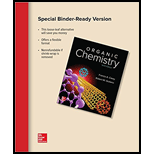
Concept explainers
Interpretation:
The reason that the unbranched isomers are less stable and boils at higher temperature while
Concept introduction:
The stability of a molecule depends on the relative strengths of attractive and repulsive forces between the atoms of the molecule.
The strength of attractive forces between the atoms increases more rapidly than the strength of repulsive forces as the structure of the molecule becomes more and more compact while the chemical formula remains the same.
The strength of intermolecular forces and attractive force between the molecule, affects the boiling point of a compound. Strength of IMFs increases with increasing surface area of the molecule when the number of valence electrons is the same. The surface area of a molecule is larger when it is less branched.
Want to see the full answer?
Check out a sample textbook solution
Chapter 2 Solutions
ORGANIC CHEMISTRY(LL)-W/ACCESS >CUSTOM<
- There are three cycloalkanes with no more than one substituent. Draw these three cycloalkanes in accordance with the ring size details provided below.Draw the structure of the cycloalkane with the largest ring below:arrow_forwardMolecules that have the same molecular formula, but different atomic connections are called constitutional isomers. Draw and name the five constitutional isomers of C6H14. Is this correct answer from this paper that I draw for the name the five constitutional isomers of C6H14? Can you explain to me that why is the different atomic connections are called constitutional isomers?arrow_forwardFor each of the following pairs, give the relationship between the two compounds. You many ignore conformational isomerism here, and any conformers may be considered to be identical compounds.arrow_forward
- Consider the following conformers of pentane:arrow_forwardUsing your knowledge of (and the definition of) cis and trans isomers and the following fact(s) about Cis/Trans Isomers please answer the following: (FACT(S): With multiple double bonds in a compound the TRANS-TRANS configuration is the most stable conformation. With multiple double bonds in a compound the CIS-CIS configuration is the least stable conformation.) Which structure is the least stable based on the information given?arrow_forwardOrganic Chemistry HW: CANNOT BE HAND DRAWN 2,6-dimethyloct-2-ene Provide a detailed typed explanation of Stereoisomers show the expanded structure of your molecule. Calculate the maximum number of possible stereoisomers of your molecule using the following formula: Maximum number of possible stereoisomers = 2n (where n= the number of chiral carbons in your molecule). This calculation does not include E- or Z- isomers for any compounds containing double bonds Type or using a computer program "draw" the possible stereoisomers of the molecule. Note that E-, Z- isomers of each stereoisomer are also possible and would not be accounted for by the formula above; draw any E- or Z- isomers.arrow_forward
- A student drew a noncyclic compound that has the molecular formula C7H14.This molecular formula is representative of an alkane, alkene, alkyne or aromatic and would be classified as saturated or unsaturated ?arrow_forwardDraw the most and least stable conformer of chloroethane and 1,2-dibromoethane.arrow_forwardWhat is the difference between a constitutional, confirgurational, and a conformational isomer?arrow_forward
 Chemistry for Today: General, Organic, and Bioche...ChemistryISBN:9781305960060Author:Spencer L. Seager, Michael R. Slabaugh, Maren S. HansenPublisher:Cengage Learning
Chemistry for Today: General, Organic, and Bioche...ChemistryISBN:9781305960060Author:Spencer L. Seager, Michael R. Slabaugh, Maren S. HansenPublisher:Cengage Learning
